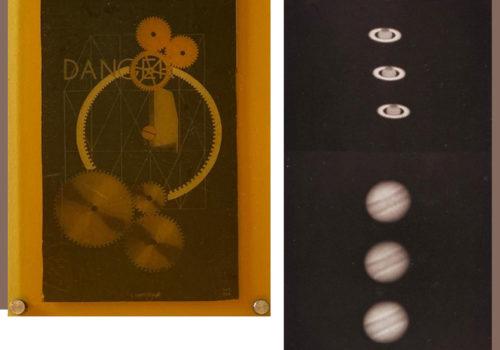This is the 30th dialogue of the Ettore Molinario Collection. A dialogue that arises from the recent acquisitions at Paris Photo and brings together the celestial mechanics of astronomical photography by Paul-Pierre and Prosper Henry and the mechanics of desire by Man Ray. Two skies, two darknesses, two «mathematical logics» that spin a tale, I believe, about the most secret gearing of my collection.
Ettore Molinario
In 1886, for the first time in the history of astronomy, Paul-Pierre Henry and his brother Prosper, opticians, astronomers, pioneers of astrophotography, successfully photographed the planets Saturn and Jupiter. For the first time, the ice rings around Saturn and the coloured bands that punctuate the surface of Jupiter appear clear. But above all, in the small, deep and warm sky of a woodburytype, the most famous father and son in the solar system appear next to each other for the first time. It is a story of terror, of death, of inexorable defeat. The myth tells that Saturn devoured his children for fear that one of them would take his place, as the oracle had predicted, and this is how Goya paints him, with his black mouth wide open resembling another universe, illuminated by a comet of blood. Jupiter, though, manages to escape the curse, because his mother replaces him with a stone as soon as he is born, and Saturn swallows it without realising the deception. Once grown, Jupiter will therefore be free to kill his father and take his place at the top of Olympus. The prophecy is fulfilled, as it had happened before. Didn’t Saturn remember that he himself had emasculated his father Uranus, ancient god of the sky, with a sickle? Didn’t he remember that divinity who governed agriculture, that he too had hated his parent and had dreamed of his death? No one can stop time, not even a god, and it is no coincidence, cruelly, that Jupiter, the son, is the largest planet in the solar system, and Saturn, the father, is the second.
Billions of millions of years after the birth of our universe and just thirty-four years after the undertaking of Paul-Pierre and Prosper Henry, another demiurge, perhaps the most Apollonian and Dionysian for the beauty and cruelty of his work, had set in motion an equal astral mechanism, an equal complexity of gears, but with the ingenious provocation expected of a Dada artist he had changed its meaning. From a gear of death it had turned into an erotic gear. In 1920 in New York, under the influence of Marcel Duchamp, Man Ray created one of the most powerful images of the American Dada season, it is that mysterious mechanism of cogwheels and words, of which the Ettore Molinario Collection now possesses the negative. In its three-dimensional physicality Danger/Dancer, where a simple syllable changes the semantic orbit of the work, is a spray-painted glass plate, which Man Ray exhibited at the Société Anonyme in New York and in 1921 at the Librairie Six in Paris. Shortly afterwards André Breton purchased it and kept it in his collection until his death in 1966. Today it is the property of the Centre Pompidou.
In his Self-Portrait, Man Ray said he had attended a Spanish dance show on Broadway and the swirling of the full skirts had suggested to him an equally seductive and dangerous dance, contemporary because it was made of gears and primitive in its violence, such as Danger/Dancer. The mechanism of the drives is all-consuming, whatever the desire might be, to stop the flow of time and generations or to possess a body. In his wicked wisdom, Man Ray had added a side note and written «Impossible» at the bottom of the negative. As if to say that no one can escape this devouring of mouths and cogwheels, this hunger for death and love.
Ettore Molinario
www.collezionemolinario.com
















